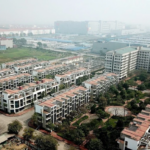The Rise of Land Speculators and Price Inflation
As soon as the proposals to merge provinces and cities were made public, land prices in many potential areas began to rise. In some localities expected to be merged, land prices have increased by 5-15% in just a few weeks. One of the reasons for this increase is the expectation of infrastructure development and the influx of people to the new administrative center. When an area is upgraded administratively, public investment in transportation, schools, hospitals, and public works will receive prioritized funding. Modern infrastructure not only improves the quality of life but also directly impacts property values.
In recent days, the land market in Viet Tri city, Phu Tho province, has witnessed a strong wave of price increases, especially in some suburban areas. This is due to information about the merger of administrative boundaries between provinces. In response to this development, local authorities have had to issue a warning about the risks of investing based on trends, which can be highly risky for inexperienced investors.

Land speculators flock to provinces with merger news, creating artificial demand.
In the Ben Got urban area (Thọ Sơn ward), dozens of land speculators arrive each day to conduct transactions, and prices continue to rise. A month ago, plots of land measuring 90 square meters were priced at about VND 1.5 billion, but now, these speculators are asking for VND 2.05 billion, an increase of over 30%. Similarly, plots of 105 square meters, previously priced at VND 1.65 billion, have now surged to VND 2.5 billion, representing a more than 50% increase.
In other areas of Phu Tho province, located 5-7 kilometers from the center of Viet Tri city, the land market is also experiencing a buzz compared to the pre-Tet period. Plots of land measuring 80 square meters and above have seen price increases of 20-30%. Currently, prices range from VND 2 to 3 billion per lot, depending on location and area.
Similarly, in Hai Phong city, several areas have suddenly become bustling with land speculators inquiring about buying and selling, and prices are rising daily. For example, a 90-square-meter plot of land in An Dong, An Duong, has increased to VND 27 million per square meter, while before Tet, it was only around VND 22-24 million per square meter. Many brokers spread rumors that “after the merger of the two provinces, land prices will skyrocket.”
Expert Warnings
Mr. Vu Cuong Quyet, CEO of Dat Xanh Northern, shared several practical perspectives and noteworthy warnings. According to Mr. Quyet, a common mistake that Vietnamese investors are currently making is the belief that “being close to administrative headquarters means higher land prices.”
“Many people think that being close to administrative headquarters means higher land prices. In reality, this area only serves civil servants who require a quiet and solemn environment, so it doesn’t attract a large population or economic activity,” said Mr. Quyet. “Property prices only soar where the economy is thriving and transportation is convenient.”
Reflecting on history, Mr. Quyet also mentioned the case of Ha Tay and Me Linh being merged into Hanoi in 2008. At that time, many people expected land prices in Ha Dong, Son Tay, and Me Linh to take off immediately after the merger. However, in reality, it took 10 to 15 years for land prices to increase due to infrastructure and economic development.
In response to the question of whether investors can find an opportunity to get ahead in the context of the current merger rumors, Mr. Quyet frankly stated, “Investors should not have high expectations. Property prices depend on the economy and infrastructure, not the administrative center. If you’re already investing in a good location, continue to do so. For example, Bac Ninh is currently a bright spot for many large investors. Even if there is a merger, billion-dollar projects that have already received funding will not shift, as the nature of the merger is to expand the development space, not change the entire economic landscape.”
Mr. Nguyen The Diep, Vice President of the Hanoi Real Estate Club, opined that the real estate market is influenced by geography and legal status. Therefore, the plan to merge provinces and eliminate the district level by changing administrative boundaries will impact the market.
Provincial mergers usually trigger an infrastructure investment wave, creating significant opportunities for real estate. However, according to Mr. Diep, mergers don’t just drive up property prices; they can also cause some areas to decrease or stabilize in price. Population movement will make the center more expensive, but the extent of the price increase will depend on planning and infrastructure investment.
In reality, when Ha Tay was merged into Hanoi in 2008, the price of land in the town of Ha Dong was only about VND 12-15 million per square meter. However, with the development of routes such as the extended Le Van Luong Street and the Cat Linh-Ha Dong metro line, prices surged.
However, not all areas have seen the same success as Ha Dong. In some areas, like Chuong My and Son Tay districts, land prices have only increased slightly and then stagnated.
Experts also warn that merger information can easily stimulate speculative psychology, potentially leading to land price bubbles.
Real-world observations indicate that using rumors to drive up land prices has previously caused a real estate bubble, leaving many investors with losses.
According to Mr. Diep, investors entering the market must grasp macro, political, and economic information. It is crucial to closely monitor planning information from state agencies to make risk-free decisions and avoid investing based on rumors.
Streamlining Administrative Procedures: Unblocking the Path to Efficient Social Housing Development
The Ho Chi Minh City Real Estate Association urges local authorities to take decisive action to remove obstacles and streamline the administrative processes related to investing in and developing social housing projects.
The Ministry of Construction to Inspect Real Estate Projects with Abnormal Price Surges
The challenge of addressing the complexities of social housing projects and curbing price manipulation and real estate speculation falls squarely on the shoulders of the Ministry of Construction. In the coming period, the Ministry, in conjunction with the Department of Housing and Real Estate Market Management, the Construction Inspectorate, and the Legal Affairs Department, will work to overcome these hurdles and bring about much-needed reforms.
The Post-Lunar New Year Property Price Puzzle
Despite positive shifts in the post-Tet real estate market, with increased property searches and a rise in listings for sale and rent, stagnant prices persist. To stimulate improved liquidity, the market requires additional strategic interventions and catalysts.





















